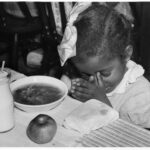School Lunch Programs


The food commodity program began in the 1930s to shore up farm prices and help American farmers who suffered during the Great Depression. At the same time, millions of people in cities lost their jobs, and were without means of support. Families were unable to pay for school lunches, and, with limited resources to provide meals at home, the danger of malnutrition among children became a national concern.
The paradox of food being plowed under while people went hungry caused the federal government to act in 1935 to aid both agriculture and needy families. The distribution of excess commodities to eligible organizations (including schools) provided the basis for federal domestic food programs, including school lunch programs.
Further Reading
Bhatia, R., Jones, P., & Reicker, Z. (2011). Competitive Foods, Discrimination, and Participation in the National School Lunch Program. American Journal of Public Health, 101(8), 1380–1386.
Woo Baidal JA, Taveras EM. Protecting progress against childhood obesity–the National School Lunch Program. New England Journal of Medicine. 2014 Nov 13;371(20):1862-5.